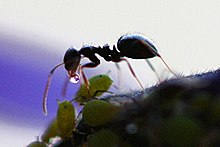Honeydew (secretion)


Honeydew is a
Honeydew-producing insects, like
In Madagascar, some gecko species in the genera Phelsuma and Lygodactylus are known to approach flatid plant-hoppers on tree-trunks from below and induce them to excrete honeydew by head nodding behaviour. The plant-hopper then raises its abdomen and excretes a drop of honeydew almost right onto the snout of the gecko.[5]
Honeydew can cause sooty mold on many ornamental plants. It also contaminates vehicles parked beneath trees, and can then be difficult to remove from glass and bodywork. Honeydew is also secreted by certain fungi, particularly ergot.[6] Honeydew is collected by certain species of birds, mosquitoes,[7][8] wasps, stingless bees[9] and honey bees, which process it into a dark, strong honey (honeydew honey). This is highly prized in parts of Europe and Asia for its reputed medicinal value. Parachartergus fraternus, a eusocial wasp species, collects honeydew to feed to their growing larvae.[10] Recent research has also documented the use of honeydew by over 40 species of wild, native, mostly solitary bees in California.[11]
Religion and mythology
In
In Greek mythology, méli, or "honey", drips from the Manna–ash (Fraxinus ornus), with which the Meliae, or "ash tree nymphs", nursed the infant god Zeus on the island of Crete[13] (as in the Hymn to Zeus by Callimachus).[citation needed]
Honey-dew is referenced in the last lines of
And all who heard should see them there,
And all should cry, Beware! Beware!
His flashing eyes, his floating hair!
Weave a circle round him thrice,
And close your eyes with holy dread,
For he on honey-dew hath fed,
And drunk the milk of Paradise.
In the Hebrew Bible, while the Israelites are wandering through the desert after the Exodus, they are miraculously provided with a substance, manna, that is sometimes associated with honeydew.[14] Exodus 16:31 provides a description: "it was like coriander seed, white, and the taste of it was like wafers made with honey."[15]
Nectar producing trees

Dates
Eucalyptus
In eucalypt forests, production of both the honeydew nectar and manna tends to increase in spring and autumn. Eucalyptus can produce even more manna than honeydew nectar. The sugar glider eats both, licking the nectar from branches. Other species attracted to the nectar include the feathertail glider, brush-tailed phascogale, and brown antechinus. Most trees are not able to produce sap if the phloem duct becomes damaged by mechanical processes.[4]
Oaks
The acorn weevil (Curculio glandium) habitually bores into the young acorns of oak trees. This injury can cause the tree to release a sweet honeydew, thought to attract wasps that can parasitize the weevil within its acorns.[citation needed] Honey bees sometimes collect this substance, in addition to honeydew from aphids feeding in oak forests, and use it to produce oak honey, an unusual varietal sold by specialist beekeepers.[17][18]
Tamarisk
Two
See also
References
- ^ S2CID 84918015.
- .
- PMC 6980476.
- ^ ISBN 9780521252928. Retrieved 25 August 2019.
- S2CID 84918015.
- ^ Ergot of Rye Archived 2018-08-09 at the Wayback Machine, APSnet.org, The American Phytopathological Society
- PMID 30717169.
- ISSN 1570-7458.
- S2CID 84967255.
- S2CID 206004844.
- ISBN 0-460-87616-3.
- ISBN 978-0-520-07925-0.
- ^ Manna#Identifying manna
- ^ "Exodus 16 :: King James Version (KJV)".
- ISBN 9780851997056. Retrieved 25 August 2019.
- ^ "Oak honey comes from Acorns". The Raw Honey Shop. Retrieved 2022-09-25.
- ^ "Miel Morbihan Bretagne". L'Abeille de Lanvaux (in French). Retrieved 2022-09-25.
- ISBN 9781877743108. Retrieved 25 August 2019.
External links
 Media related to Honeydew at Wikimedia Commons
Media related to Honeydew at Wikimedia Commons
